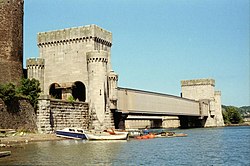Conwy Railway Bridge Pont Rheilffordd Conwy | |
|---|---|
 Conwy Railway Bridge across the River Conwy | |
| Coordinates | 53°16′49″N 3°49′25″W / 53.280278°N 3.823611°W |
| Carries | North Wales Coast Line |
| Crosses | River Conwy |
| Locale | Conwy |
| Maintained by | Network Rail |
| Heritage status | Grade I listed |
| Cadw | 3236 |
| Followed by | Conwy Suspension Bridge |
| Characteristics | |
| Design | Tubular bridge |
| Material | |
| Total length | 463 ft (141 m) |
| Width | 42 ft (13 m) |
| Clearance below | 46 ft (14 m) (low tide) |
| Design life | 1899: cast iron piers are added to reduce the load on the tubes and permit heavier trains |
| History | |
| Architect | Francis Thompson (architect) |
| Engineering design by | Robert Stephenson in collaboration with William Fairbairn and Eaton Hodgkinson |
| Constructed by | William Evans |
| Construction start | 1846 |
| Construction end | 1848 |
| Opened | 1849 |
| Location | |
 | |
The Conwy Railway Bridge carries the North Wales coast railway line across the River Conwy between Llandudno Junction and the town of Conwy. The wrought iron tubular bridge, which is now Grade I listed, was built in the 19th century. It is the last surviving example of this type of design by Stephenson after the original Britannia Bridge across the Menai Strait was partially destroyed in a fire in 1970 and rebuilt as a two-tier truss arch bridge design.
The Conwy Railway Bridge was designed by railway engineer Robert Stephenson in collaboration with William Fairbairn and Eaton Hodgkinson.[1] The original plan had been for suspension bridge complementing Thomas Telford's Conwy Suspension Bridge of 1826. After Stephenson's appointment as chief engineer, the design was changed because a suspension bridge was considered unsuitable for trains. Stephenson and his collaborators invented the wrought-iron box-girder structure to bridge the River Conwy in a single span.
During May 1846, groundwork for the bridge commenced. The architect Francis Thompson dressed the pylons at either end as barbicans, with crenellated turrets, arrow slits and bartizans to complement the adjacent Conwy Castle. Unusually, the tubes were completed onshore before being attached to pontoons, floated along the river and jacked into position between the abutments. The bridge was officially opened in 1849. The bridge endorsed the construction of the larger Britannia Bridge. During 1899, the tubular sections were reinforced with cast iron columns to reduce the load on the span across the river. In September 1950, Conwy Tubular Bridge was recognised as being a Grade I listed building; it is also a scheduled monument (CN167).